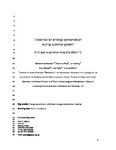Evidence for energy conservation during pubertal growth. A 10-year longitudinal study (EarlyBird 71)
| dc.contributor.author | Mostazir, M | |
| dc.contributor.author | Jeffery, Alison | |
| dc.contributor.author | Hosking, Joanne | |
| dc.contributor.author | Metcalf, B | |
| dc.contributor.author | Voss, L | |
| dc.contributor.author | Wilkin, T | |
| dc.date.accessioned | 2017-01-04T14:14:19Z | |
| dc.date.issued | 2016-10-04 | |
| dc.identifier.issn | 0307-0565 | |
| dc.identifier.issn | 1476-5497 | |
| dc.identifier.uri | http://hdl.handle.net/10026.1/8191 | |
| dc.description.abstract |
BACKGROUND: Diabetes is closely linked to obesity, and obesity rates climb during adolescence for reasons that are not clear. Energy efficiency is important to obesity, and we describe a temporary but substantial fall in absolute energy expenditure, compatible with improved energy efficiency, during the rapid growth phase of puberty. METHODS: In a longitudinal cohort study lasting 10 years, we measured voluntary energy expenditure as physical activity (PA) by accelerometry, involuntary energy expenditure as resting energy expenditure (REE) by oxygen consumption, body mass index (BMI) and body composition by dual energy X-ray absorptiometry annually on 10 occasions from 7 to 16 years in the 347 children of the EarlyBird study. We used mixed effects modelling to analyse the trends in REE and their relationship to BMI, lean mass (LM), fat mass (FM), age, PA and pubertal stage. RESULTS: Relative REE and total PA fell during puberty, as previously described, but the longitudinal data and narrow age-range of the cohort (s.d.±4m) revealed for the first time a substantial fall in absolute REE during the period of maximum growth. The fall became clearer still when adjusted for FM and LM. The fall could not be explained by fasting insulin, adiponectin, leptin, luteinising hormone or follicle stimulating hormone. CONCLUSIONS: There appears to be a temporary but substantial reduction in energy expenditure during puberty, which is unrelated to changes in body composition. If it means higher energy efficiency, the fall in REE could be advantageous in an evolutionary context to delivering the extra energy needed for pubertal growth, but unfavourable to weight gain in a contemporary environment. | |
| dc.format.extent | 1619-1626 | |
| dc.format.medium | Print-Electronic | |
| dc.language | en | |
| dc.language.iso | en | |
| dc.publisher | Springer Science and Business Media LLC | |
| dc.subject | Absorptiometry, Photon | |
| dc.subject | Adolescent | |
| dc.subject | Basal Metabolism | |
| dc.subject | Body Composition | |
| dc.subject | Child | |
| dc.subject | Energy Metabolism | |
| dc.subject | Exercise | |
| dc.subject | Female | |
| dc.subject | Humans | |
| dc.subject | Longitudinal Studies | |
| dc.subject | Male | |
| dc.subject | Oxygen Consumption | |
| dc.subject | Pediatric Obesity | |
| dc.subject | Puberty | |
| dc.subject | United Kingdom | |
| dc.title | Evidence for energy conservation during pubertal growth. A 10-year longitudinal study (EarlyBird 71) | |
| dc.type | journal-article | |
| dc.type | Journal Article | |
| dc.type | Research Support, Non-U.S. Gov't | |
| plymouth.author-url | http://gateway.webofknowledge.com/gateway/Gateway.cgi?GWVersion=2&SrcApp=PARTNER_APP&SrcAuth=LinksAMR&KeyUT=WOS:000388127600003&DestLinkType=FullRecord&DestApp=ALL_WOS&UsrCustomerID=11bb513d99f797142bcfeffcc58ea008 | |
| plymouth.issue | 11 | |
| plymouth.volume | 40 | |
| plymouth.publication-status | Published | |
| plymouth.journal | INTERNATIONAL JOURNAL OF OBESITY | |
| dc.identifier.doi | 10.1038/ijo.2016.158 | |
| plymouth.organisational-group | /Plymouth | |
| plymouth.organisational-group | /Plymouth/Faculty of Health | |
| plymouth.organisational-group | /Plymouth/Faculty of Health/Peninsula Medical School | |
| plymouth.organisational-group | /Plymouth/REF 2021 Researchers by UoA | |
| plymouth.organisational-group | /Plymouth/REF 2021 Researchers by UoA/UoA03 Allied Health Professions, Dentistry, Nursing and Pharmacy | |
| plymouth.organisational-group | /Plymouth/Research Groups | |
| plymouth.organisational-group | /Plymouth/Research Groups/Institute of Translational and Stratified Medicine (ITSMED) | |
| plymouth.organisational-group | /Plymouth/Research Groups/Institute of Translational and Stratified Medicine (ITSMED)/CBBB | |
| plymouth.organisational-group | /Plymouth/Research Groups/Institute of Translational and Stratified Medicine (ITSMED)/CCT&PS | |
| plymouth.organisational-group | /Plymouth/Research Groups/Plymouth Institute of Health and Care Research (PIHR) | |
| plymouth.organisational-group | /Plymouth/Users by role | |
| plymouth.organisational-group | /Plymouth/Users by role/Academics | |
| dc.publisher.place | England | |
| dcterms.dateAccepted | 2016-08-30 | |
| dc.rights.embargodate | 2017-4-4 | |
| dc.identifier.eissn | 1476-5497 | |
| dc.rights.embargoperiod | 6 months | |
| rioxxterms.versionofrecord | 10.1038/ijo.2016.158 | |
| rioxxterms.licenseref.uri | http://www.rioxx.net/licenses/under-embargo-all-rights-reserved | |
| rioxxterms.licenseref.startdate | 2016-10-04 | |
| rioxxterms.type | Journal Article/Review |


